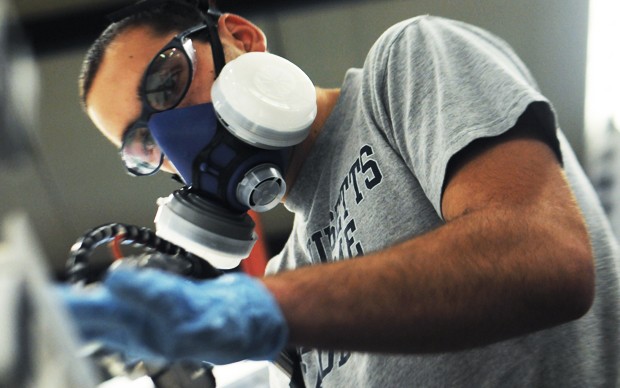Undergraduates at the University of Minnesota are participating in the construction of the near detector, a neutrino detector prototype which will work with the future NOvA lab detector. Both the near detector and the NOvA detector, also called the far detector, will study neutrinos, which are extremely small particles with little or no mass that pass through matter. The new NOvA lab will be 25 miles northeast of Orr, Minn. Construction of the lab is still underway and will be finished sometime in 2010. âÄúWeâÄôre in the stages of assembling and testing the modules over at the lab,âÄù said Josh Imobersteg , one of the undergraduates currently working on the project. The project is called the near detector because of its proximity to Fermilab, which is located about an hour west of Chicago in Batavia, Ill. There, the beam of neutrinos is generated and sent out to eventually be studied by the NOvA lab in Minnesota, physics and math undergraduate Tom VandenBoom said. Fermilab conducts research on high-energy physics. The parts built for the near detector will be sent there. Marvin Marshak, the project coordinator, said NOvA needs two practically identical detectors. Since the near detector is smaller, it was built first as prototype of the far detector. âÄúIdeally what we want [the neutrinos] to do is to change from one type to another in the several hundred mile journey between [the two labs],âÄù VandenBoom said. The undergraduates are currently gluing together parts for the detector, like PVC pipes, and checking for leaks, VandenBoom said. The students have been working in a lab on the St. Paul campus every day of the week with some students putting in hours on the weekends. Teams of about three students work on one module together, Imobersteg said. Devices called bubblers are used to check for leaks. The bubblers, which are essentially a tank, are hooked up to the module to check for bubbles. A large amount of bubbles indicates a leak. With three bubblers, students are able to test as many as 15 of the modules, which will make up part of the near detector, simultaneously, he said. Imobersteg, an aerospace engineering and mechanics major, got involved because of his curiosity. âÄúI guess personally, I always like seeing what potential something has,âÄù Imobersteg said. âÄúThese particles have been around since the earliest point in time.âÄù Physics undergraduate David Strandberg has been involved with the project since the beginning of the summer. Those students who began working recently are more specialized in making modules, while those who started during the summer and have more experience are helping with many tasks and overseeing the project, Strandberg said. About 10 students were hired over the summer, Stranberg said. Now the numbers of workers are growing. Eventually, there could be as many as 100 undergraduates involved, he said. âÄúItâÄôs really interesting to be a part of a project that is happening right now and is researching something new and exciting,âÄù Strandberg said.











